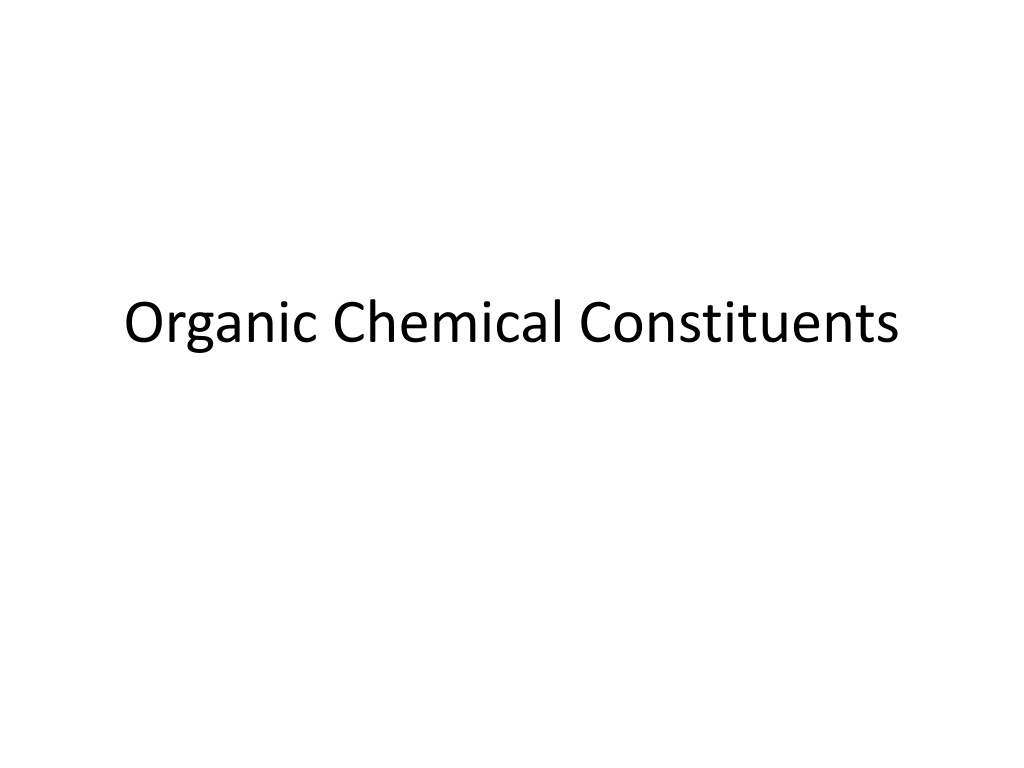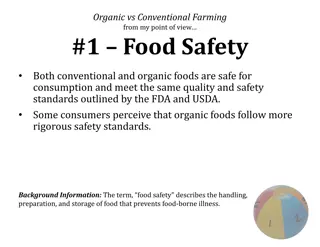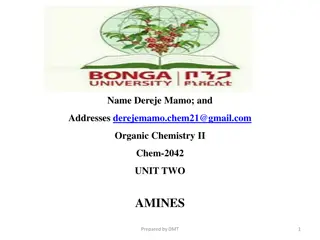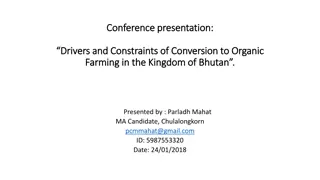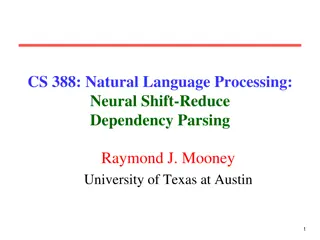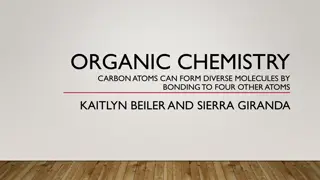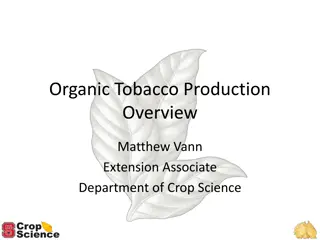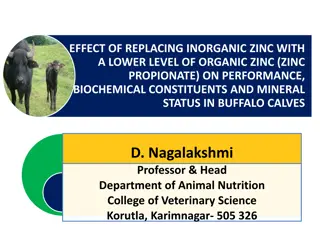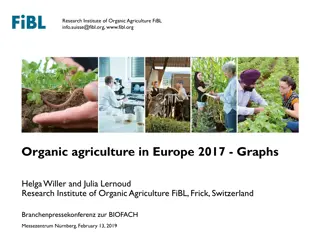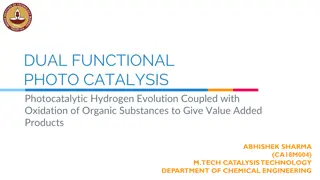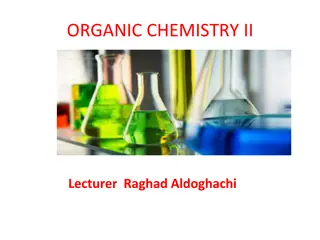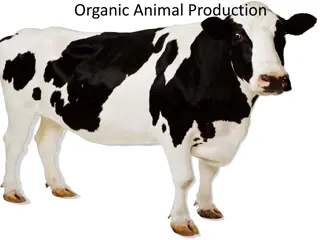Organic Chemical Constituents
A variety of organic compounds can impact water quality, leading to taste, odor, and toxicity issues. Organic substances are composed of carbon, hydrogen, nitrogen, and oxygen, and can originate from natural sources, human activities, or chemical reactions during disinfection. Differentiating organic from inorganic compounds is based on strong carbon-carbon bonds. Common inorganic compounds like carbon monoxide and dioxide lack these bonds. Organic molecules vary widely in size and molecular weight, ranging from simple compounds to complex polymers. Natural organic matter found in water bodies is derived from biological processes.
Download Presentation

Please find below an Image/Link to download the presentation.
The content on the website is provided AS IS for your information and personal use only. It may not be sold, licensed, or shared on other websites without obtaining consent from the author.If you encounter any issues during the download, it is possible that the publisher has removed the file from their server.
You are allowed to download the files provided on this website for personal or commercial use, subject to the condition that they are used lawfully. All files are the property of their respective owners.
The content on the website is provided AS IS for your information and personal use only. It may not be sold, licensed, or shared on other websites without obtaining consent from the author.
E N D
Presentation Transcript
A variety of organic compounds that can affect water quality are found in drinking water supplies. Several types of organic chemicals cause disagreeable tastes and odors in drinking water, and other types are known to be toxic. Many organic contaminants are known to be carcinogenic or are classified as cancer-suspect agents. The term organics refers to the general class of chemicals composed of carbon (C) and one or more of the following elements: hydrogen (H), nitrogen (N), and oxygen (O)
The term organic was used long time ago when substances were categorized as inorganic when they were obtained from mineral sources and as organic when they were derived from living organisms. Today, many organic compounds are derived from sources other than biological activity. A wide variety of materials are synthesized by the chemicals industry. The molecular structure of these synthesized compounds may also contain atoms of sulfur (S), phosphorus (P), and/or one or more of the halogens, that is, fluorine (F), chlorine (Cl), bromine (Br), and iodine (I), as well as a variety of other elements.
There are many chemical species that are commonly considered to be inorganic in spite of having C, H, O, and N within their structure. Examples of such compounds include carbon monoxide (CO), carbon dioxide (CO2), carbonate (CO3- 2), and bicarbonate (HCO3). The principal structural feature that distinguishes organic compounds from inorganic substances is the existence of strong carbon carbon bonds.
The molecular weight of organic compounds ranges from 16 g/mol for methane(CH4) to values approaching one million 106 grams per mole for polymeric materials. The dimension of organic molecules varies from less than1 nm for simple compounds to approximately 0.1 m for complex organic polymers.
Sources of Organic Compounds in Drinking Water: There are three major sources from which organics may be introduced to drinking water: 1. Natural organic material. 2.Compounds originating from human activities. 3.Compounds formed through chemical reactions that occur during disinfection.
Natural organic matter (NOM): is the term used to describe the organic chemicals originating from natural sources that are present in all water bodies. Natural organic matter originates from a water body due to biological activity, including secretions from the metabolic activity microorganisms, and higher life-forms; decay of organic matter by bacteria. Concern about NOM has focused on its ability to react with chlorine and form disinfection by- products, which are often carcinogenic. of algae, protozoa,
Organic compounds from human activities: Organic chemicals from industry, agriculture, and municipal effluents are routinely found in water supply sources and in trace amounts in many water supplies. Surface waters are especially exposed to these types of contaminants, but groundwater systems can also become contaminated. Organic chemicals from industry: Industries that utilize manufacturing processes are major sources of organic pollutants The vast majority of organic compounds used in industry are synthesized. large quantities of chemicals in
Agricultural pesticides and herbicides The vast majority of these substances are organic chemicals. the use of such large quantities of agricultural chemicals requires that programs be developed to monitor water supplies subject to agricultural runoff. Municipal wastewater discharges Municipal wastewater treatment plants are a major source of organic contamination. Even with effective secondary treatment, an increasing number of organic compounds is being found in the effluent from treatment plants.
a number of compounds termed emerging organic compounds are now being found in stream waters. Many of the emerging compounds are derived from veterinary and human antibiotics, drugs, and industrial and household wastewater products.
Organic Compounds Formed During Disinfection: A variety of organic compounds can be formed through chemical transformations of NOM during water disinfection. For example, chlorine can efficiently convert humic substances (NOM) to trihalomethanes (THMs) and other organohalogen oxidation products under the reaction conditions encountered in water treatment systems.
Measurement and Classification Of Organic Carbon The complexity of organic matters makes it impractical to routinely measure individual compounds. Instead, they typically quantified using certain parameters. The most common parameters in water treatment are TOC and UV254absorbance.
The TOC test is used to determine the total organic carbon in an aqueous sample. The test methods for TOC utilize heat and oxygen or other oxidizing agent to convert dissolved organic carbon (while excluding inorganic carbon compounds) to CO2 which is measured with an infrared analyzer or by other means. TOC monitoring results for treated water prior to primary disinfection using chlorine should generally not exceed 2.0 mg/L.
UV254absorbance: UV is light that is beyond the visible spectrum at the violet end, generally defined as having a wavelength between100 and 400 nm. Many organic compounds can absorb ultraviolet (UV) radiation as a result UV absorption has been used as a measure for the organic compound. The UV wavelengths at which absorption is determined is typically 254 nm.
